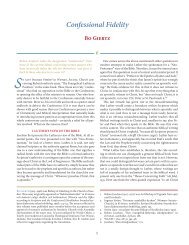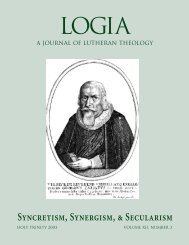The Lord's Supper in the Theology of Martin Chemnitz Bjarne - Logia
The Lord's Supper in the Theology of Martin Chemnitz Bjarne - Logia
The Lord's Supper in the Theology of Martin Chemnitz Bjarne - Logia
You also want an ePaper? Increase the reach of your titles
YUMPU automatically turns print PDFs into web optimized ePapers that Google loves.
<strong>The</strong> Consecration |<br />
two natures <strong>in</strong> <strong>the</strong> God-Man Christ Jesus. Because <strong>of</strong> this personal<br />
union Jesus Christ, true God and Man <strong>in</strong> one person, is present <strong>in</strong><br />
many places. His presence cannot be limited to <strong>the</strong> circumscriptive<br />
(localiter oder, circumscriptive — HS 119), and one must dist<strong>in</strong>guish<br />
Christ’s general omnipresence from His def<strong>in</strong>itive presence (HS 116–<br />
121; see paragraphs 88–117, esp. 94–100). 45<br />
180 <strong>The</strong> second po<strong>in</strong>t which is necessary for a correct understand<strong>in</strong>g <strong>of</strong><br />
<strong>the</strong> doctr<strong>in</strong>e <strong>of</strong> <strong>the</strong> Lord’s <strong>Supper</strong> is to accept Christ’s words, “This<br />
is my body” <strong>in</strong> <strong>the</strong>ir simple, natural sense. One must understand <strong>the</strong><br />
mode <strong>of</strong> predication. Christ is here describ<strong>in</strong>g <strong>the</strong> sacramental union,<br />
a mode which Lu<strong>the</strong>r calls “synecdoche,” and <strong>of</strong> which he gave many<br />
examples from Scripture and which he fur<strong>the</strong>r expla<strong>in</strong>ed by means <strong>of</strong><br />
common usage <strong>in</strong> everyday language (LW 37, 296–303; see p. 53–64).<br />
<strong>The</strong>re is a “union <strong>of</strong> effect.” <strong>The</strong> bread is not deified nor annihilated<br />
and <strong>the</strong> body has not been elim<strong>in</strong>ated through some figure <strong>of</strong> speech.<br />
Lu<strong>the</strong>r’s example <strong>of</strong> <strong>the</strong> Holy Spirit appear<strong>in</strong>g <strong>in</strong> <strong>the</strong> form <strong>of</strong> a dove is<br />
analogous. <strong>The</strong> Holy Spirit did not stand <strong>the</strong>re visibly present but <strong>in</strong><br />
<strong>the</strong> form <strong>of</strong> a dove (LW 37, 299, 337). Even though body and bread are<br />
two dist<strong>in</strong>ct substances, never<strong>the</strong>less <strong>the</strong>y are united and designated<br />
as one substance. Both bread and body rema<strong>in</strong>, and by virtue <strong>of</strong> <strong>the</strong><br />
sacramental union it is correct to say, “This is my body,” designat<strong>in</strong>g<br />
<strong>the</strong> bread with “this.” It is, as Lu<strong>the</strong>r says, now “flesh-bread,” and<br />
not ord<strong>in</strong>ary w<strong>in</strong>e out <strong>of</strong> <strong>the</strong> cellar but “blood-w<strong>in</strong>e” (LW 37,303).<br />
Thus Lu<strong>the</strong>r, through <strong>the</strong> explication <strong>of</strong> <strong>the</strong>se two po<strong>in</strong>ts, helps <strong>the</strong><br />
Christian reader to a better understand<strong>in</strong>g <strong>of</strong> <strong>the</strong> Lord’s <strong>Supper</strong> (HS<br />
121–124).<br />
181 In addition to <strong>the</strong>se two vital factors, <strong>the</strong>re is a third that is necessary<br />
for an understand<strong>in</strong>g <strong>of</strong> <strong>the</strong> Lord’s <strong>Supper</strong>, and that is <strong>the</strong> doctr<strong>in</strong>e <strong>of</strong><br />
<strong>the</strong> consecration. In Wittenberg Carlstadt had attempted to destroy<br />
<strong>the</strong> true doctr<strong>in</strong>e <strong>of</strong> <strong>the</strong> sacrament by teach<strong>in</strong>g that <strong>the</strong> touto referred<br />
to Christ’s body as He sat at <strong>the</strong> <strong>Supper</strong>, and also by <strong>in</strong>sist<strong>in</strong>g that<br />
Christ’s body is now restricted to heaven. 46 His third thrust aga<strong>in</strong>st<br />
<strong>the</strong> Scriptural doctr<strong>in</strong>e was to ridicule <strong>the</strong> consecration as merely<br />
be<strong>in</strong>g some k<strong>in</strong>d <strong>of</strong> external manipulation on <strong>the</strong> level <strong>of</strong> magic. In<br />
his rejection <strong>of</strong> <strong>the</strong> consecration as an effective cause for <strong>the</strong> present<br />
church’s certa<strong>in</strong>ty that it has <strong>the</strong> same <strong>Supper</strong> <strong>the</strong> Lord <strong>in</strong>stituted for<br />
His church <strong>in</strong> His last testament, Carlstadt ridiculed it by a gross distortion<br />
<strong>of</strong> what Lu<strong>the</strong>r taught. It was a sore spot with Lu<strong>the</strong>r and <strong>the</strong>




